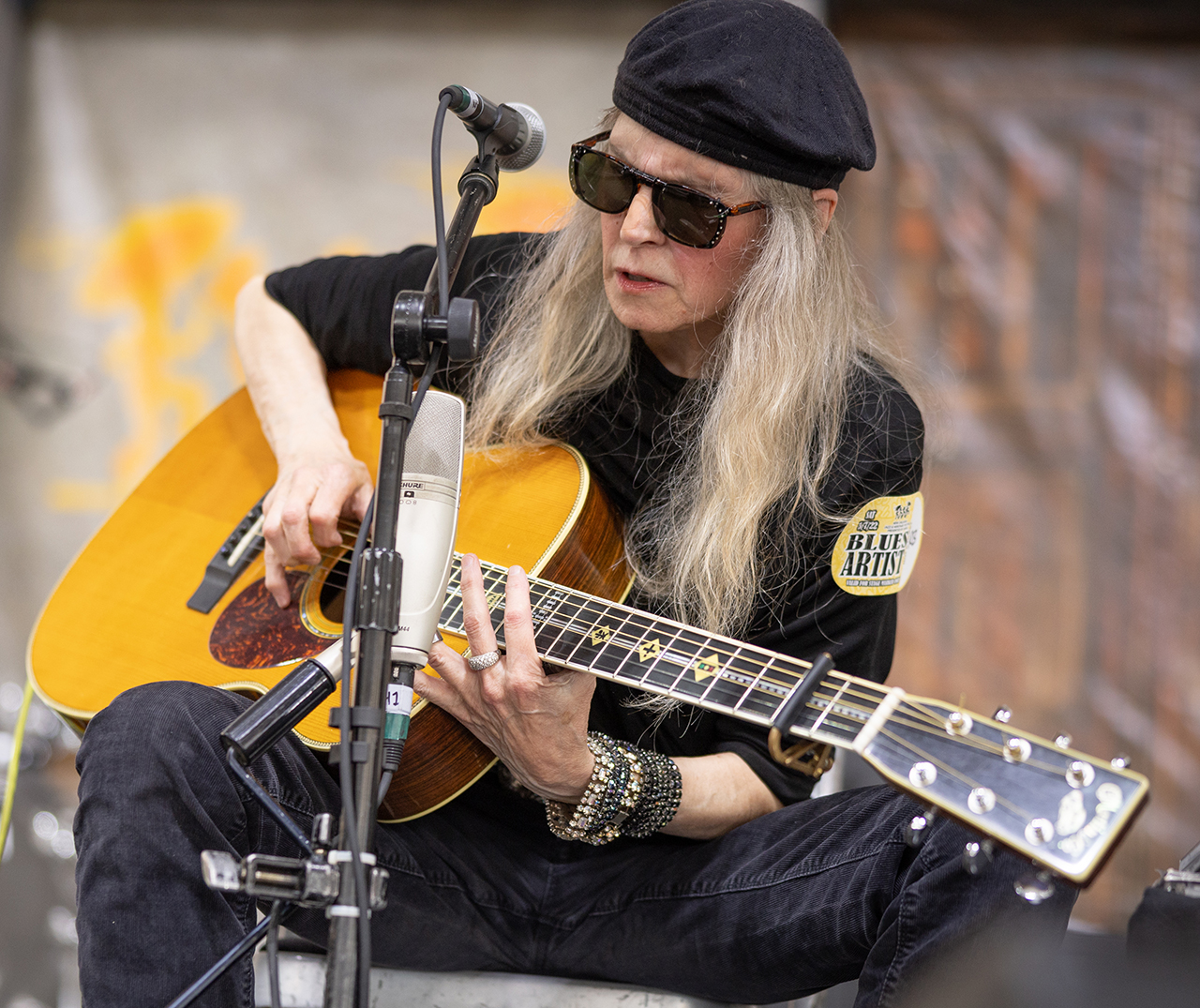“Son House rolled his eyes back and tossed his head – he seemed to go into a trance, snapping and slamming the strings”: Rory Block left home as a teenager then met and impressed her blues heroes
She refined her skills with help from Skip James, John Hurt and Fred McDowell, wound up with a signature Martin guitar, and with advice from Maria Maulder, fought self-doubt to deliver new album Heavy on the Blues

Rory Block came of age in the psychedelic 1960s, but her musical tasted led her somewhere more traditional. “The moment I heard country blues, I was drawn to it,” she says. “It spoke to what was in my heart. It was gorgeous, meaningful, powerful and soulful, and it felt deeply personal. It was the most haunting and beautiful music.”
After leaving home as a teenager she caught the ear of blues masters such as Son House, Fred McDowell and John Hurt. “I was always treated with a very warm feeling of acceptance,” she recalls. “Perhaps it’s because I played some of the same material. I believe there was an understanding that they were being honored.”
Since then, Block has released dozens of records and won numerous awards with her trusty Martin OM-40 in hand. Her latest record, Heavy on the Blues, delivers classic downhome, old-school acoustic blues, and she’s not slowing down. “Music is a universal language; and I’ve always said that the music community is really a big family.”
When you left home, you made connections with Son House, Fred McDowell and John Hurt. Were you always a fan?
I’d already been working hard on transcribing early blues. I was familiar with the music of those founding artists. Growing up in Greenwich Village during the roots music revival of the 1960s, I was exposed to just about every American music style from the 20th century.
I was in the right place at the right time to meet Son House, Skip James, Mississippi John Hurt, Bukka White, Reverend Gary Davis and Mississippi Fred McDowell. My dad was a country fiddle player, so we were connected to a small and dedicated group of music lovers.
They played in the old styles, searched for the early masters and sought out vintage recordings. I was the beneficiary of that research, working on transcribing as much as I could.
All the latest guitar news, interviews, lessons, reviews, deals and more, direct to your inbox!
Can you remember your earliest interactions with the blues?
At 14 years old, I lay in bed every night with headphones on, listening to these rediscovered records. I transcribed Mississippi John Hurt's version of Frankie and Albert before meeting him, which added to the joy when I got to hear him play it in person.
Reverend Gary Davis lived in the Bronx, where Stefan Grossman and a handful of others took lessons from him. That was my daily reality, and I didn’t realize how fleeting it was. We thought everyone in the world was a musician!
It must have been incredible to see the players you grew up loving brough into the forefront.
Son House was rediscovered by Dick Waterman and two others who were traveling around, knocking on doors and sleuthing out leads. Waterman went on to manage Son, Bonnie Raitt and even me for a while.
Tragically, Robert Johnson had died earlier; Charley Patton and Tommy Johnson, too. I can only imagine how great it would have been if they’d had been alive.
What did you learn from the greats that you still apply today?
Son House was first and foremost a passionate player. He rolled his eyes back and tossed his head when he played – he seemed to go into a trance, snapping and slamming the strings, and playing with total commitment.
Mississippi John Hurt was a gentle spirit, humble and soft-spoken. But behind his peaceful demeanor lay a burning energy. I learned that what he did was far more complex than what one might perceive at first.
Can you remember the first time you met Son House?
Dick Waterman brought Son to Stefan’s parents’ apartment in New York City, where I spent one-on-one time with him. We started talking about Willie Brown and Robert Johnson, and Son told me he taught Robert Johnson how to play.
I could clearly see their influence on each other based – shared material, shared styles and shared tunings. Walking Blues and Death Letter Blues are essentially the same song done by two different artists in unique ways. You didn’t always notice the overlap until looking closer.

Is it true that Son was surprised by your chops?
I played Future Blues and Walking Blues for him. He looked at Dick and Stefan and asked, “Where did she learn to play like this?” There must have been an amount of surprise when he saw his music was being revered, studied, and emulated decades later.
What about Mississippi John Hurt?
He welcomed us into his home to play music. He was a gentle spirit who was gracious to everyone. I was unaware at the time, but I later discovered that he’d endured considerable hardship – he hadn’t been properly compensated for his work.
Growing up around musicians, it seemed we all understood that Martin guitars were the best in the world
And what was Fred McDowell like?
He was from a slightly younger generation, with one foot in the early blues and the other in modern electric blues, similar to Muddy Waters and Elmore James. Fred seemed a little less surprised and a little more contemporary when I met him!
You’ve long been associated with Martin guitars.
Growing up around musicians, it seemed we all understood that Martin guitars were the best in the world. When I was 14, Stefan and I hitchhiked coast to coast, stopping at pawn to search for Martins. Stefan would go in and say, “Got any old guitars?”
They’d come out of the back with a pre-war pearl inlay Martin that needed a neck reset. They’d say something like, “Gotta have $50,” and that was how Stefan started an amazing collection of priceless Martins.
That same year, I remember sitting in the artist’s area with Tom Paxton at a festival in Berkeley. I had one of Stefan’s Martins and told Tom it was worth $1,500. He was incredulous. It seemed like a million dollars at the time – later you could add two more zeros!
How important has that signature Martin, the OM-40, been to you?
I longed for a Martin of my own but they were always out of reach. One day I got a call from Martin’s artist rep, Dick Boak. He told me they wanted to make a signature model in my name. I almost fainted!
Dick and I designed on dinner napkins at a restaurant near the factory. When I picked it up I was walking on air. Martin gave me the #1 in the series and a couple of the prototypes. It’s a deeply moving part of my journey – a real landmark for me.
You released Heavy on the Blues in August. Since it’s a blues record, were there any hardships while making it?
Once the recording process begins there are no hardships, just joy. I love recording. The hard part is the doubt that can set in before starting, when I wonder, ‘Will I ever be good again?’
I’ve recorded 14 projects for Rounder Records, 12 for Stony Plain, and a few brief forays with other labels. Just as I was about to start recording, Stony Plain was sold to a catalog-only company. Artists, publicists, and promo people were all cut loose.
I went into a deep despair. Maria Muldaur said ‘Get up and find a new label – we have a lot more music to give’
I went into a deep despair, thinking my career was over. It wasn’t be the first time I’d felt that way. I usually experience a lull between projects – sometimes when I’m waiting for a record to come out I begin to doubt myself. The worst thing is not knowing.
So I called my old friend Maria Muldaur for a little sisterly advice. She said, “Listen to me, little sister: don’t get depressed. Don’t get angry. Just get up and find yourself a new label, because we have a lot more music to give.” I called two labels – and both wanted to sign me!
Mark Carpentieri of MC Records injected me with fresh enthusiasm. He said, “You’ve done all these tributes; you’ve done themed albums; you’ve had lots of success. Now it's time to do whatever you want. Just do Rory Block.”
The new CD swings from the earliest country blues to hard-driving electric blues, from Charley Patton to Koko Taylor. And I brought in some great players for collaborations.
We also managed to pick up a smaller tour vehicle, now that my big bus is grounded with 340,000 miles of hard rolling. We got back on the road and drove 10,000 miles through the North Country and Midwest, followed by a coast-to-coast trip. There’s nothing to complain about!
- Heavy on the Blues is out now.
Andrew Daly is an iced-coffee-addicted, oddball Telecaster-playing, alfredo pasta-loving journalist from Long Island, NY, who, in addition to being a contributing writer for Guitar World, scribes for Bass Player, Guitar Player, Guitarist, and MusicRadar. Andrew has interviewed favorites like Ace Frehley, Johnny Marr, Vito Bratta, Bruce Kulick, Joe Perry, Brad Whitford, Tom Morello, Rich Robinson, and Paul Stanley, while his all-time favorite (rhythm player), Keith Richards, continues to elude him.
You must confirm your public display name before commenting
Please logout and then login again, you will then be prompted to enter your display name.






